CSotD: AAEC/ACC 24, Day 2
Skip to comments
Day Two of the AAEC/ACC Conference in Montreal began with the Americans conducting a business meeting while the Canadians held a panel on digitization and conservation, apparently in both languages, unless the Billy Ireland’s Jenny Robb is fluent en francais, since she was one of the presenters.

After lunch, we were reunited and began a full afternoon with a presentation by doctoral candidate Nancy Perron on images of French Canada, specifically centered on Alberic Bourgeois, who created this weekly feature with two main characters being rural French Canadians.


The type “Baptiste” represented is a longtime steadfast in Canada, both in serious work, advertising and cartooning.

Bourgeois converted a speech on humor and technique into a series within his regular weekly feature, and while the cartoonist here is surrounded by familiar characters from the feature, he’s quite a different physical type than Bourgeois himself, though perhaps equally beleaguered.
“Is cartooning an art, a job or a profession?” the character’s wife asked, with the answer being that it largely depended on the cartoonist’s own attitude, while, writing in 1927, he said he enjoyed making people laugh in what was a rough time, but needed to dig into them without hurting them.
Nearly a century later, that seems a reasonable summary of things.

Another UQAM graduate student, John Barbour, then introduced the group to Raoul Barré, a multitalented artist who even produced posters for plays in which he designed sets and acted in the last years of the 19th Century.

Barré produced one of the first comic strips in Canada in 1902, then created Noahzark in 1913, writing in English for an American audience and translating it into French for readers back in Quebec.

Then, in 1914, he began to work in animation, which became the Grouch Killers series, roughly at the same time Winsor McCay was working on Gertie.

It was necessarily simple work, each feature beginning with live-action characters reading a comic that segued into the animation.

A few years later, Barré went to work on Felix the Cat’s early animated cartoons.

But he kept his hand in the advertising business as well.

And he provided the frontispiece and other illustrations for a 1924 edition of Dinah Craik’s 1893 classic children’s novel, The Little Lame Prince and his traveling cloak.

We then leapt up to current day with a presentation by Jacques Goldstyn (Boris) of the Montreal Gazette, who introduced the issue of censorship with a reminder about Ali Farzat, a Syrian cartoonist who had both his hands broken in an attack after he criticized the government.

Goldstyn spoke of the feeling of having a variety of groups looking over the shoulder of a political cartoonist, waiting to pounce on any perceived slight or insult, including editors who don’t want to take angry phone calls and much prefer political cartoons about orange traffic construction cones than about more controversial topics.

The real danger, he suggested, is that the cartoonist becomes his own censor, making choices that reflect caution rather than his own opinions.

At which point he provided an unintentional demonstration: He put up this unpublished and unpublishable cartoon, whose heading translates as “Kill Page One,” an equivalent phrase to “Stop the Presses,” and a reference to the Charlie Hebdo murders.
The piece brought cries of protest from some in the audience, including one walkout and a shout for him to take it down, on the basis that it was too harsh and insensitive, particularly for those who had known some of the cartoonists killed in the attack.
My own editorial opinion is that I agree with Goldstyn that it was harsh and unpublishable, but I found it an interesting example of how a cartoon envisioned from within the ivory tower can be theoretically protected, but is felt deeply by the people genuinely involved in the issue.
While he wasn’t looking to provoke the uproar, I heard a few people say afterward that there could have been a whole session simply to hash that out.
As it was, there were impassioned but less fraught conversations in the break following his presentation.

It was a good intro for Matt Wuerker of Cartoonists Rights and Patrick Chappatte of Freedom Cartoonists’ presentation on cartoonists’ rights to free expression. Their organizations, now working closely together, coordinate not simply lobbying but active intervention for cartoonists around the world who are threatened with jailing and violence for their views.

They’ve joined together under the United Nations to combine annual awards, in order, they explained, not to compete with each other but to elevate their work in an international forum at Geneva each year, where the celebration of World Press Freedom Day expands into a month-long event celebrating the role of political cartoonists in promoting human rights.

One of the current award winners is Hong Kong cartoonist Zunzi, who has seen his long career there ended in the wake of the takeover of the one-time British colony by Beijing.
In the short video, he explained that tyrants like to be portrayed as cruel, but they become furious if they are portrayed as idiots and morons, which is all the motivation a cartoonist needs.

In this piece, the administrator tells the policeman he is doing wrong, that “You should use something to make him stop screaming first.”

And he notes the difficulty of adjusting to the red lines in a place where rights had been guaranteed, but the lines have been changed.
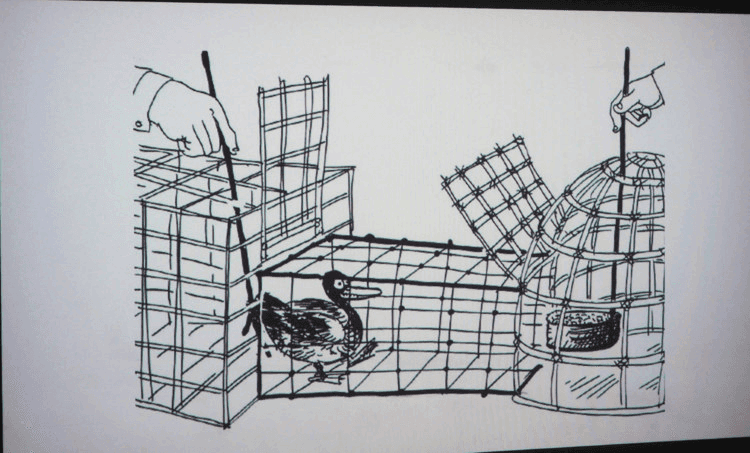
And he suggests that perhaps the change in governance wasn’t all that much of a change after all.
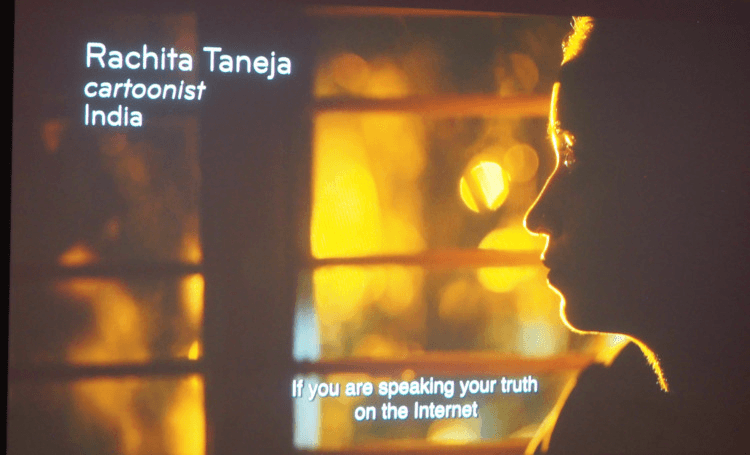
The other recipient of an award this year is Rachita Taneja, a 26-year-old Indian whose position at the other end of the age scale makes for a contrast with Zunzi, since she brings a simple cartooning style to her work, along with a stubbornness of purpose that seems more personal than political.
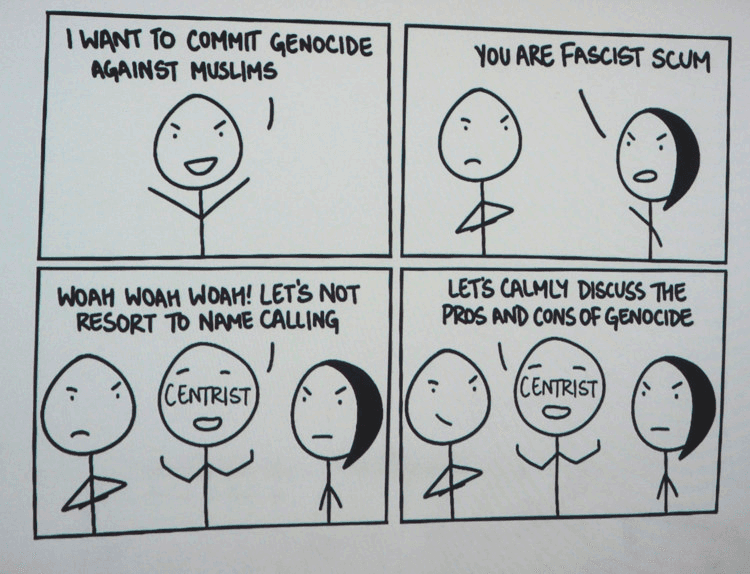
However simple her style, it has not gone down well with the Indian government, which is not simply Hindu-dominated by numbers but by intent and by legislation.

Taneja, however, does not get bogged down in detailed analysis, and her simple style creates its impact by assuming that life should be fair and logical, even when the evidence clearly indicates that it is not.

It is a style of simplicity that assumes there is value in taking a beating because it will encourage others to rise up alongside you. (Note that the bloodied fist remains raised among those new participants.)


Stay tuned on this one, because not only will there be a fundraiser later this year that will include some cartoon art to bid on, but the Herblock Foundation is sponsoring a new venture to bring more stories of these courageous freedom fighters to the public.

It was, however, nice to lighten up then, as AAEC President Jack Ohman interviewed cartoonist Joel Pett in an easy-going laugh-provoking exchange.

Pett’s criticism of Kentucky Governor Wallace Wilkinson in the late 80s/early 90s spawned a regular series of Wally World cartoons, but ended when he left office with a memorable correction:


While Pett’s attitude towards Mitch McConnell called for a series of slides including a couple of composites to do it justice.
For the record, Pett claims he depicted McConnell as a turtle years before Jon Stewart cited the similarities.

However, Pett tackled serious issues with dry, dark humor, both within Kentucky …

… and in the wider world.

And, as Ohman noted, he’s not afraid to go after broad, philosophical matters as well as specific issues.

Lalo Alcaraz introduced himself as the most recently hired staff cartoonist in America, having landed a job at Calo, a Los Angeles regional publication emphasizing Chicano community matters.
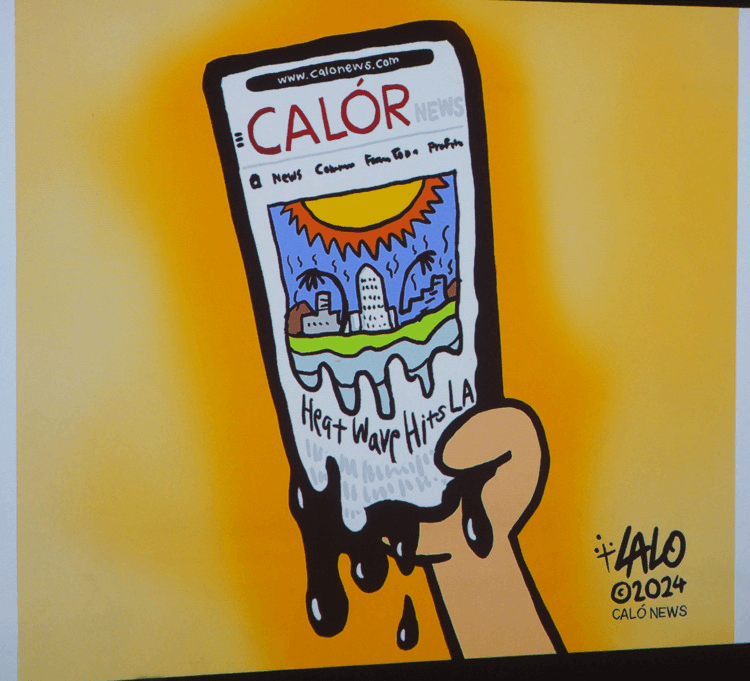
Being the new guy doesn’t stop him from punning on his employer’s name, a bit of pachuco spanglish, by adding a letter to make it about this summer’s heat.

But he also addresses more serious issues, like the local sheriff’s office having its own set of tattooed gangs.
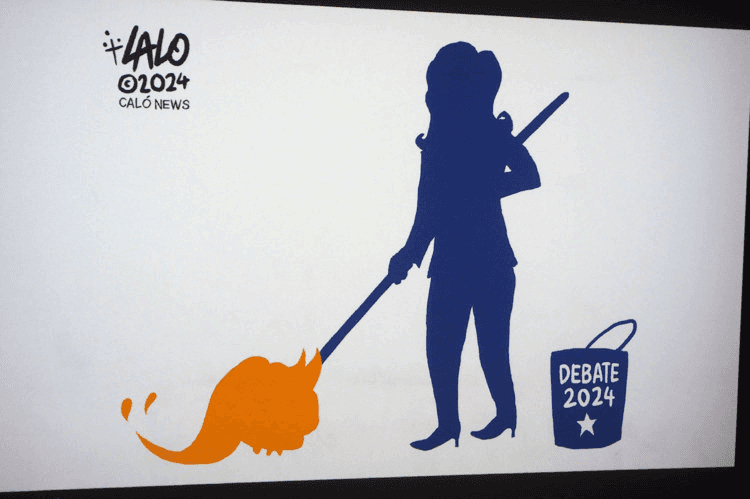
And even national issues.

Then Steve Brodner closed out the presentations with a selection of Trump caricatures he particularly admired, like this Barry Blitt portrait.

And Melinda Beck‘s commentary on how the New York Times has been covering the upcoming election.

The day, and the conference, ended with presentation of awards, and much as I’d like to say journalistic standards prevent me from providing a series of grip-and-grin photos, the truth is my camera batteries were all dead.
However, the AAEC’s Ink Bottle for service above and beyond was awarded to Wes Tyrell, president of the ACC, for his overall help in the past year plus his setting up of a conference several veterans said was the best in many years.
The Rex Babin Award, given for local cartooning, went to Dennis Draughon, who is charge of holding feet to the fire in North Carolina.

As he did when the name of a Confederate turncoat was removed from a local military base.

And as he did when the unpleasant bits of state history were removed from the social studies curriculum.

Marc Murphy was runner-up for the Babin Award. Murphy, BTW, is incoming president of the AAEC.
The Canadians then presented the Townsend Award, named for George Townsend, a British military commander who had a penchant for drawing funny pictures of his fellow officers and politicians and may have been the continent’s first political cartoonist.
The French-language winner was Marc Beaudet:


“Sorry, Teddy: Your operation must be postponed … to free up beds for our covid cases.”
And in English, the award went to Sue Dewar:


While the Brian Gable “Honorary Canuck Award” went to Scott Burns, who is parliamentarian for the AAEC and the National Cartoonists Society as well as having helped the ACC with a variety of topics, and the ACC also invented and awarded the “Golden Gable Award” to Christian Vachon, curator of the Musee McCord Stewart, who not only helped set up the conference but is a vast repository of comics culture.
Surprise Surprise!
I don’t have a song that fits, but since I’m just getting over being too shy to try my French — as we leave, of course — here’s the funniest thing I’ve ever seen on TV and you don’t have to be bilingual to figure out what’s going on.
It sure didn’t help him.


Comments 4
Comments are closed.